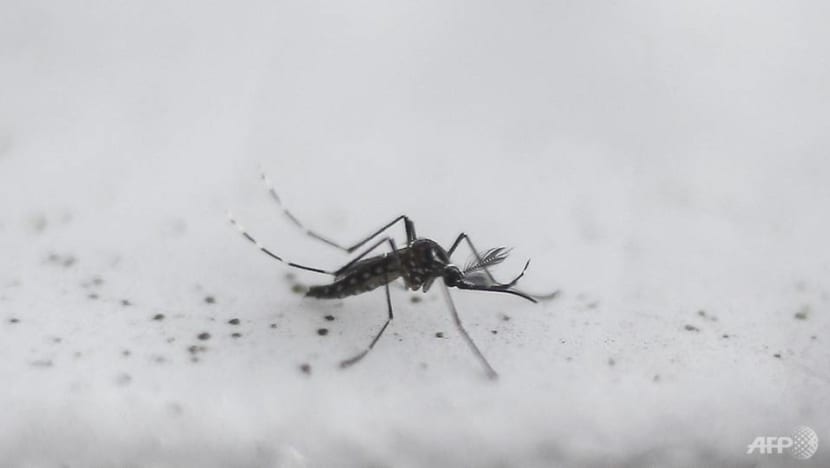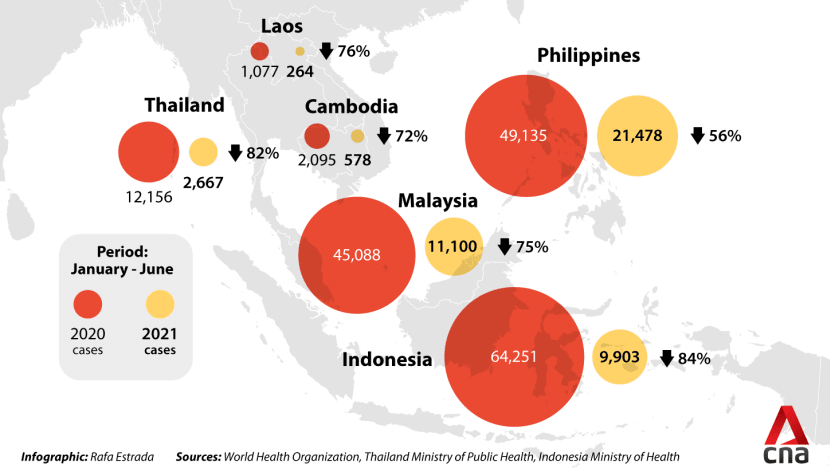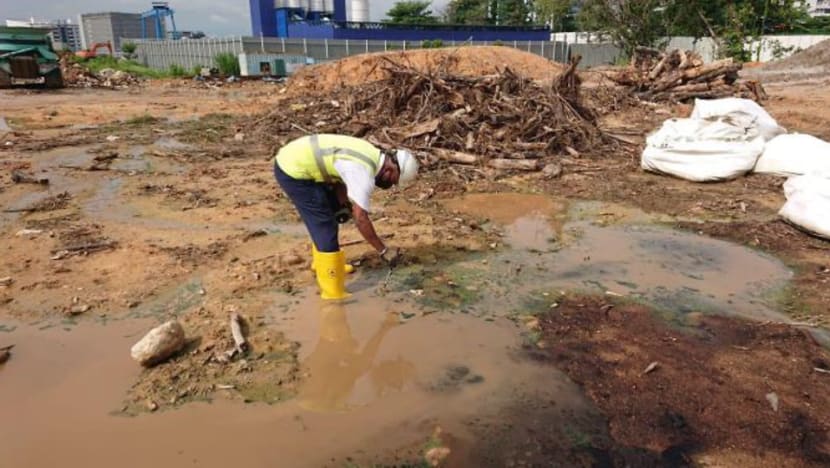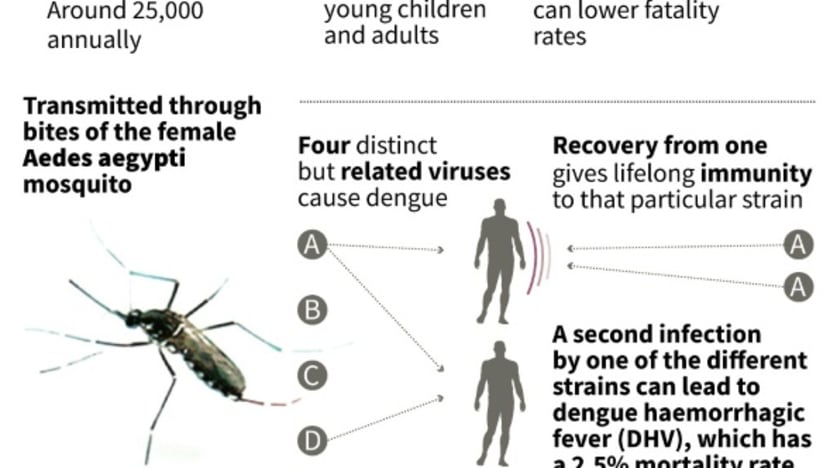Why the dengue fever caseload has plummeted in parts of Southeast Asia this year

An Aedes aegypti mosquito. (File photo: AFP/Miguel Schincariol)
BANGKOK: Underreporting from strained medical systems and extensive social lockdowns could explain why many Southeast Asian countries have recorded substantially fewer cases of dengue fever in 2021 than previous years, said experts.
Data from the World Health Organization (WHO) suggests that several countries are enjoying vastly improved dengue fever situations this year, including Malaysia, Thailand, Indonesia, the Philippines, Cambodia and Laos.

Other nations, including Singapore and Vietnam are experiencing dengue cases on par with seasonal expectations, according to WHO.
READ: Higher risk of dengue transmission as Aedes mosquito population growing islandwide, says NEA
Dengue fever is a potentially deadly disease spread by infected Aedes aegypti mosquitoes. The populations of these mosquitoes typically rapidly increase in the pre-monsoon period and monsoon season, as humidity, temperature and rainfall rise. Its alternative name is “breakbone fever”, due to the associated muscle and joint pain symptoms.
While there is consensus that 2021 is not a bad year for dengue fever infections in the region, especially compared to 2019, the statistics may not necessarily reflect the true nature of the spread of the disease.
“I think there’s a number of things at play here. One is people aren’t going to medical centres with fever in the same way they would normally, because of COVID,” said Martin Hibberd, a professor of emerging infectious diseases at the London School of Hygiene and Tropical Medicine.
“Secondly, the health centres are not in their normal responsive mode. Their priorities are elsewhere and they’re not testing as much as they would. So the numbers reported must be less,” he told CNA.
A WHO spokesperson did not identify any clear evidence for why dengue cases were declining but said there could be several possible reasons, including more proactive vector control, stronger national surveillance systems and better communication with the community.
As well, the overwhelming demands of handling the COVID-19 pandemic might have seen dengue monitoring drop to a lesser priority in some places, the spokesperson said in response to CNA's queries.
“Unfortunately, COVID-19 has impacted a range of routine health-related programmes in many countries.
“Detection and reporting of dengue cases are also believed to have been impacted by reduced access to health facilities, and a hesitancy to seek medical care at facilities due to concern of possible exposure to COVID-19 patients,” the spokesperson added.

LOCKDOWN IMPACTS
As the COVID-19 pandemic hit early last year, many experts had hypothesised that social lockdowns and people spending extended periods of time at home would result in an uptick of dengue. The statistics suggest that the opposite may have been true.
“The perceived wisdom is that dengue infections happen at home; your mosquitoes live in the house. We thought if more people stayed at home there would be more dengue but that’s clearly not the case,” Hibberd said.
“There might be a little bit of local migration, but it could be that outside of home plays a more important part in dengue transmission than we thought. Maybe your workplace or your school or your other places have been important contributors of dengue transmission in the past.”
WHO concurred, noting that lesser movements could have actually decreased people’s exposure to mosquitoes.
Dr Rafdzah Ahmad Zaki, a senior lecturer in Epidemiology at the University of Malaya believes the COVID-19 lockdowns in Malaysia have had a strong effect in slowing the spread of the disease.
“A significant reduction of cases were seen during the implementation of full lockdown,” she said, noting that people spending time at home meant fewer outdoor hosts for mosquitoes to make contact with, and less human waste reduced breeding sites.
Because the initial symptoms of both COVID-19 and dengue are similar, she doubts that patients would willingly avoid medical treatment even if they were scared of the pandemic, a factor that otherwise could contribute to the reduced recorded case numbers.
“I would think that the shifting priorities and resources of the health system to COVID-19 would more likely increase the number of cases. With the current situation, people who are concerned with their health will seek health advice and early treatment,” she said.

LINK BETWEEN CLIMATE CHANGE AND DENGUE TRANSMISSION?
Factors such as increasing urbanisation, unplanned high-density housing, inefficient mosquito control and normal levels of international travel and trade were cited by the WHO as reasons for dengue spread. But it downplayed the role of climate change.
“While the relationship between dengue incidence and climate change have been extensively studied globally, no clear evidence has been demonstrated. Besides, dengue transmission is closely associated with various socio-environmental factors as well as climate change,” the WHO spokesperson said.
But Hibberd disagrees. “Climate change is definitely going to affect dengue cases. It’s only a matter of time before it spreads,” he said.
Climate change is already starting to shift the geographies of possible future dengue spread. As the climate warms, Aedes aegypti mosquitoes are on the march, moving into communities where dengue fever has not historically been a problem.
“Slowly those Aedes aegypti are moving northwards and places like Vietnam, where traditionally Hanoi doesn't have many cases and Ho Chi Minh City does, slowly the mosquitoes are moving up the country as the climate changes,” Hibberd said.
“What you need is Aedes aegypti occupying those cities and you’re ripe for dengue to turn up.”
There has been encouraging progress with scientific research on innovative new ways to tackle the disease.

A recent large-scale trial in Yogyakarta in Indonesia saw mosquitoes carrying a naturally occurring bacterium called Wolbachia introduced into the environment, with the aim of boosting the immune systems of local mosquitoes and making them less prone to transmitting viruses.
The study resulted in a 77 per cent decrease in dengue, making it highly successful and building upon similar research done in Brazil, Colombia, Sri Lanka and Vietnam.
READ: Anti-dengue Wolbachia mosquito project shows ‘promising results’; to cover all Tampines, Yishun HDB towns from July
Elsewhere, Singapore's National Environment Agency has been conducting phased field studies to evaluate the use of male Wolbachia-Aedes mosquitoes to suppress the urban Aedes aegypti mosquito – the primary vector of dengue, chikungunya and Zika viruses in the city-state.
Overall, despite the positive outlook in 2021, the dengue story in this region remains a problematic one. Hibberd said that the “long-term trends are all up", noting that therapies and vaccines are still a distant hope.
The WHO has implored countries to build up their capacity to handle the disease. The cyclical nature of dengue fever means a more serious outbreak is expected within the next two or three years.
“Unfortunately, dengue continues to be neglected, with a lack of resources at the country level and declining operational funds in recent years in the region,” the spokesperson said.














